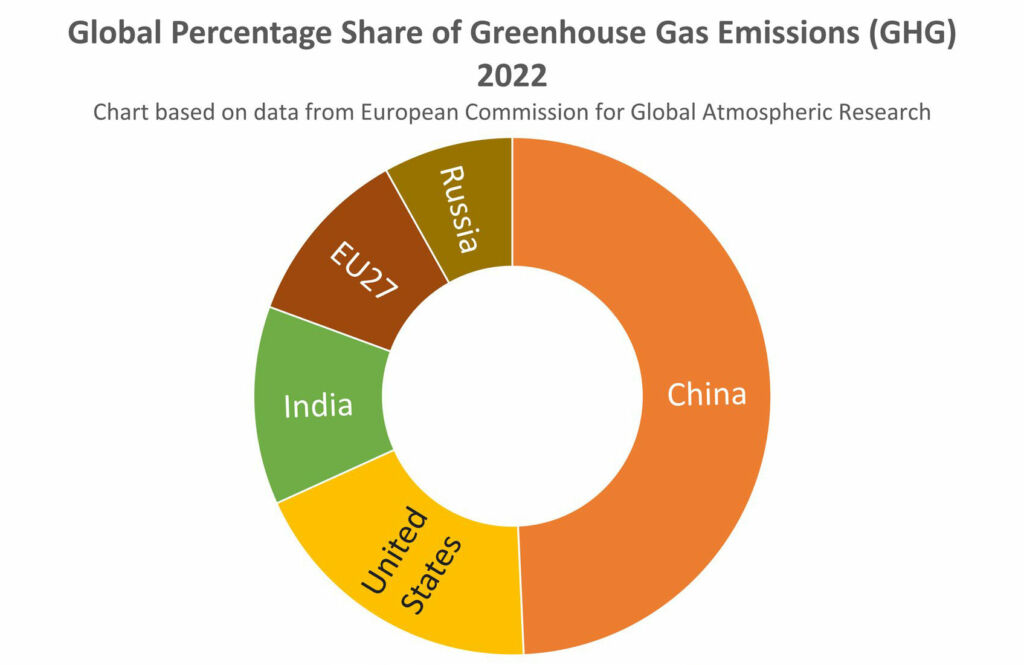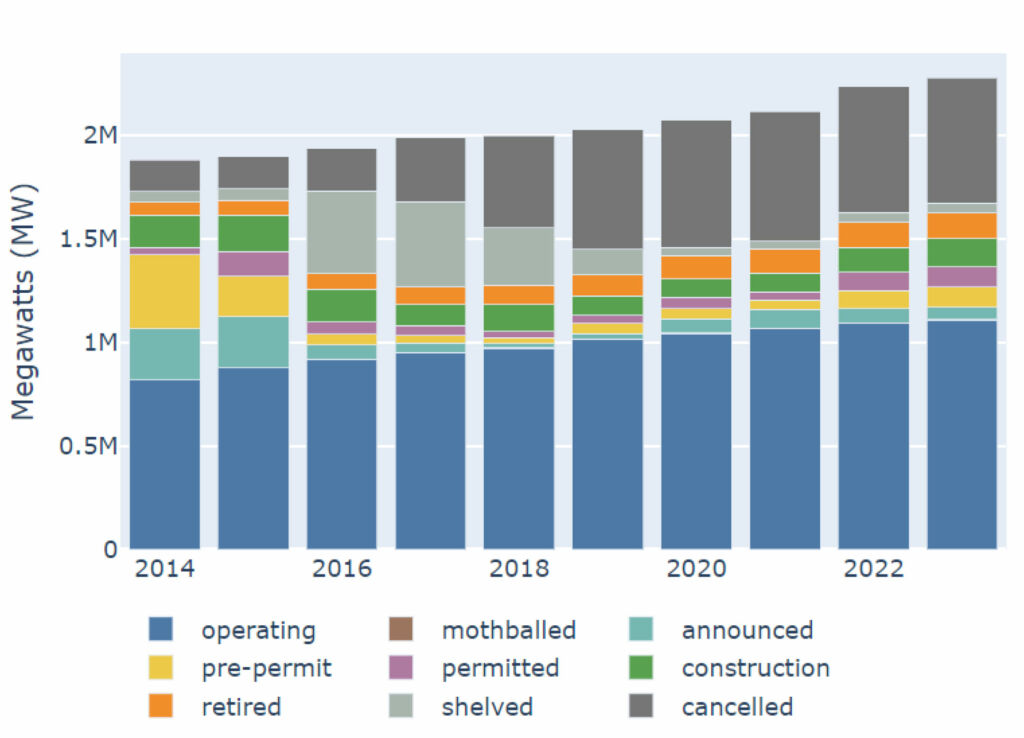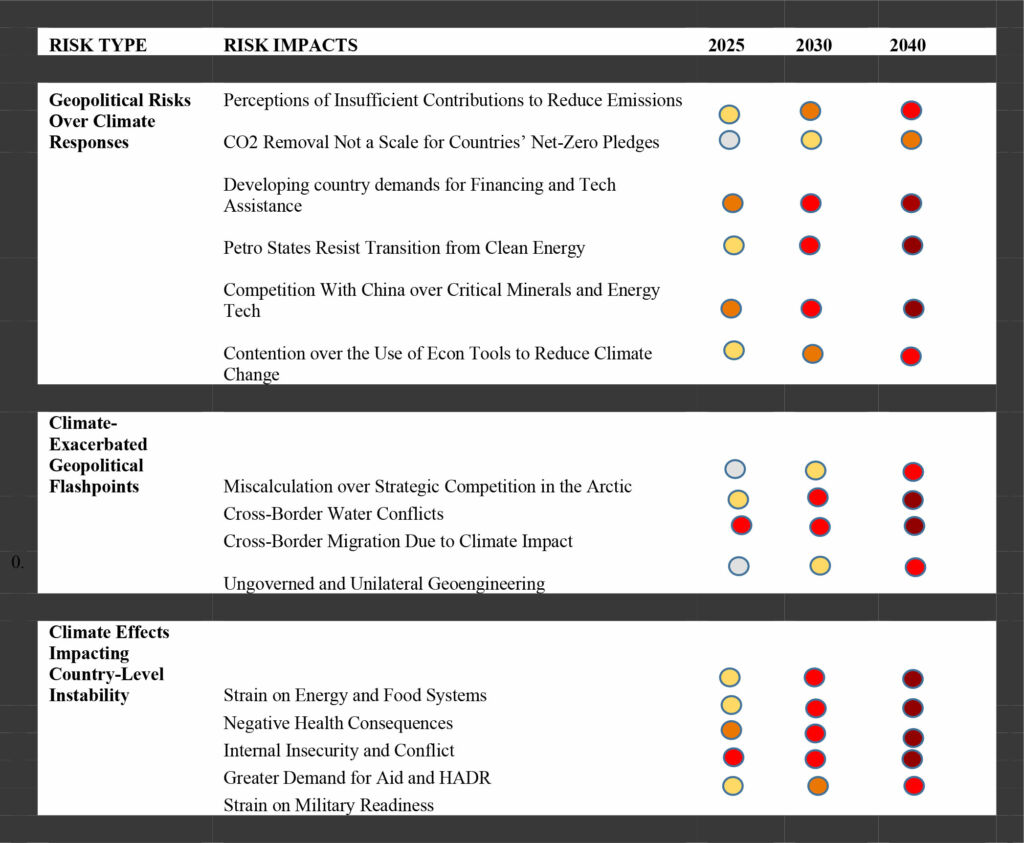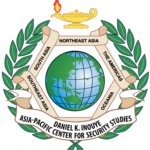Dr. Ethan Allen, Dr. Sebastian Kevany, and Dr. Srini Sitaraman, DKI-APCSS
Summary
Between escalating active kinetic conflicts and the ever-growing and ever-more-severe environmental impacts of climate disruption, governments around the world are facing increasingly complex choices in dealing with simultaneous and sequential crises. Never before in human history have so many states had to juggle so many disasters in such a short time frame, and our governance mechanisms are, in many cases, woefully inadequate for this overwhelming task. The trends strongly suggest the situation will only get worse in upcoming years. Successfully coping with and improving our degrading physical and geopolitical environments will require a significant shift in mindset on the part of leaders around the world to a fundamental recognition of the unity of humanity — a turning away from short-term, self-centered, nationalistic thinking and adoption of a longer-term, more inclusive view of the common needs and interests of all persons on this planet.
Introduction
The world is witnessing simultaneous, multi-tiered, and multidimensional security challenges, including two major armed conflicts between Russia and Ukraine and another between Hamas and the State of Israel. Besides these two conflicts, there are regional security tensions in the South China Sea, the Taiwan Straits, the India-Pakistan border, the India-China border, and several armed conflicts in Africa. While the world is grappling with multiple military conflicts, the planet is also seeing a dramatic increase in major natural disasters, such as the destructive fires on the Island of Maui in Hawaii, forest fires earlier in the summer in Canada, earthquakes in Morocco and Afghanistan, flooding in Libya and Pakistan, and glacial lake outbreak flood in Sikkim in India.
On top of all these challenges, our world is still recovering from the devastating impact of the COVID-19 virus, estimated to have caused 7 million deaths worldwide. The effect of the virus was not only felt in the health sector, which left many countries unable to cope with a massive and far-reaching health emergency, but its far-reaching economic, social, and political impact is still reverberating. The economic and political consequences of a shutdown caused by the COVID-19 pandemic led to the collapse of a government in Sri Lanka, triggered food riots in Pakistan, underreported social unrest in China, military coups in Western Africa, worldwide food inflation, and conspiracy theories and anti-vaccine controversies.
Everything is happening all at once everywhere, and it is taxing the ability of governments, international organizations, and NGOs to address multiple complex disasters that require emergency assistance, long-term economic reconstruction aid, and, most importantly, political will to find lasting solutions.
Argument
This essay explores the consequences of these simultaneous, multi-tiered, and multidimensional security challenges ranging from armed conflicts to the effects of climate change and natural disasters. Mainly, the essay asks the question as to whether we are equipped and prepared to confront the simultaneity of multiple crises – i.e., different sorts of disasters driven by different causes happening at the same time. We argue that deliberate and coordinated planning, on a broader scale and of a more inclusive approach than is currently employed, is required to remain resilient and ready to tackle these global multidimensional challenges simultaneously. We also posit that the world is fundamentally unprepared to confront multiple wars, natural disasters, economic failures, and political coups all at once because leadership, both in domestic and international settings, is not thinking in terms of simultaneity. Just as a city’s water system is not prepared for multiple water main breaks at the same time, governments around the world are not ready for multiple simultaneous emergencies that tax multiple systems and reduce the effectiveness of responders to everything everywhere all at once.
In physics, the concept of simultaneity recognizes that two events that are spatially separated could occur in the same timeframe, but interpreting such occurrences depends on the observer’s framework. Borrowing from the concept of simultaneity, we assess that policymakers should remain prepared to recognize and respond to multiple and increasingly complex emergencies of different causal streams occurring in either geographically or temporally separated timeframes. For instance, a country could simultaneously experience multiple natural disasters amidst an ongoing civil war or an economic crisis, which could trigger a coup or a political crisis.
The authors propose that the first step to confronting multi-layered conflicts and security challenges requires acknowledging that the world is entering uncharted waters, especially on the climate and natural disaster fronts. Our world has to go beyond mere acknowledgment of climate-change-driven natural disasters and understand that climate disruption is causing extreme temperature fluctuations, droughts, floods, and crop failures, and it is dimming the economic prospects of large groups of people. These sorts of stressors inevitably will lead to large-scale political protests and economic volatility, which will, in turn, cause mass migration of people to new locales, increasing the prospect of identity and economic conflicts. We are already witnessing mass movements of people such as the Rohingya of Myanmar to the neighboring countries in South and Southeast Asia, Central and South Americans coming to North America via perilous land routes in sustained waves, and economic and conflict refugees making arduous trips across the Mediterranean to Europe. According to the UN’s Intergovernmental Panel on Climate Change report, each year, “natural disasters force an average of 21.5 million people from their homes around the world.”
It is predicted that over the next three decades, as the planet gets hotter, “143 million people are likely to be uprooted by rising seas, drought, searing temperatures and other climate catastrophes.” The IPCC report (p.1079) points out that “most climate-related migration and displacement observed currently takes place within countries” and the “climate hazards most commonly associated with displacement are tropical cyclones and flooding in most regions, with droughts being an important driver in sub-Saharan Africa, parts of south Asia and South America.” Climate-related migration falls into different categories: (1) temporary and seasonal; (2) indefinite and permanent; (3) internal; (4) international; (5) rural-to-urban or rural-to-rural; (6) displacement; and (7) planned/organized resettlement. Future migration and displacement patterns related to climate change will depend not only on the physical impacts of climate change, but also on the future policies and planning at different levels of the government (2022 IPCC Report). The ability to manage the growing tensions surrounding cross-border migration requires enormous international coordination and cooperation, which is currently lacking.
Geopolitical Tensions and Global Conflict
Geopolitical tensions and wars are the result of unresolved territorial and resource disputes, identity clashes, strategic competition, or due to unbridled ambitions of the rulers such as Vladimir Putin and Xi Jinping. As the Cold War balance of power politics game came to a sudden conclusion in the late 1980s, the world seemingly entered an era of neoliberal globalization aided by economic liberalization and technological innovation. Countering this trend, in 1998, India and Pakistan conducted nuclear tests in violation of the Nuclear Nonproliferation Treaty (NPT) and followed it up with a major border war in 1999, heightening regional tensions and reviving the specter of nuclear war.
The progress of liberalization derailed in many parts of the world because of the wars in the Balkans, the 9/11 terror attacks, and the wars in Iraq, Afghanistan, Libya, and Syria. Besides these significant conflagrations, many other battles started happening in different parts of the world, such as the multi-sectoral ethnic clashes in Central Africa originating in the Democratic Republic of Congo, the genocide in Rwanda, and the eruption of a civil war in Somalia. Meanwhile, a long-running civil war in Sri Lanka, which concluded in 2009 after a massive military operation, and an ongoing ethnic war in Myanmar, which is controlled by a military junta, also broke out. We also saw the tensions in the Korean peninsula worsen due to the aggressive North Korea’s nuclear and missile program, heightening tensions in the Taiwan Straits and South China Sea. Across the planet, a series of micro and macro struggles ignited by root causes such as territory, resources, ideology and identity, ambition and ego of leaders, and strategic competition continue to burn without any lasting resolution.
According to the Geneva Academy’s Armed Conflict Tracker, currently, forty-five armed conflicts are happening in the Middle East and North Africa, thirty-five in the African Continent, twenty-one in Asia, seven in Europe, and six in Latin America, bringing the grand total to 114 conflicts. Many of these clashes involve non-state actors and foreign interventions by states both in the region and major outside powers, which taxes the ability of states and international organizations to respond to other pressing policy challenges and frequently occurring natural and man-made disasters, such as the Fukushima and Chernobyl nuclear disasters. The Fukushima nuclear catastrophe was a classic cascading disaster caused by a major undersea earthquake generating a massive tsunami off the coast of Japan, which in turn led to a major nuclear accident.
Climate Change and Global Response
In a Pew Research Survey conducted across 19 countries and published in August 2022, 75% of the participants agree that Climate Change is a major threat, and 19% indicate that it is a minor threat; only 5% say that it is not a threat. Clearly, there is strong global opinion suggesting that Climate Change is a clear and present danger to planetary life systems. The challenge, however, has always been how politics at both the domestic and international levels can move from public opinion consensus to functional climate policy that balances the immediate current needs of the global population and the health and stability of the planet.
While responding to climate-related natural disasters has always been a part of the defense and security workforces’ task, the numbers, severity, and human impacts of these events are rapidly increasing, adding stressors, since the threats from traditional geopolitical adversaries have not decreased, as noted above. Not only are security forces around the globe having to respond to more frequent and larger climate-driven crises, but their own day-to-day operations are being complicated even more by climate-related threats such as inundation from sea level rise, flooding from extreme rainfall events, and heat waves. So, while the tasks of responding to challenges have increased, security forces must now take on proactive roles in adapting to climate disruption impacts or risk being overwhelmed by these rapidly evolving changes.
In addition, because defense and security forces are significant contributors to carbon dioxide emissions, many are now charged by their governments with proactively mitigating their carbon footprints. This is a particularly difficult process to accomplish while operating at a high level, as when engaged in conflict situations, such as the 114 conflicts mentioned previously. These complex challenges are being faced not just in a few locales but rather by security workforces around the globe that are stressed, leaving fewer resources to be shared with allies, partners, and those in need or in crisis. Moreover, this situation is evolving in an ever more challenging environment where once-in-a-century-type natural disasters are becoming commonplace.
Difficulties of Reducing the Global Carbon Footprint
Environmental and climate change threaten us, our allies, and our adversaries, and limit access to natural resources, exacerbate internal and international tensions, and increasingly drive people toward conflicts. Paradoxically, this is happening just while the planetary scope and scale of these changed conditions raise threats that ever more clearly mandate deeply cooperative, collaborative, and innovative approaches to working with both allies and adversaries. It is clear that significantly reducing climate-changing carbon dioxide emissions on a global scale will require that the United States (US), the People’s Republic of China (PRC), India, and the European Union (EU), who together contribute the bulk of these greenhouse gases, put aside doctrinal and ideological differences and closely coordinate programs to reduce their outputs. While Asia, outside of China, contributes significantly to CO2 emissions, these are spread among a large number of nations that are not tied together, as is the EU, and the other, non-PRC, individual countries of Asia do not contribute anywhere near the amounts of the four entities identified above.
Renewable energy’s footprint is growing faster in India compared to other major economies, but India remains highly reliant on coal, which contributes nearly 80% to its overall energy needs. As the Indian economy continues to grow and expand, the demand for energy is likely to expand, and the dependency on fossil fuels, especially coal and oil, will only grow. Meanwhile, China, one of the largest consumers of coal, is “emitting almost a third of all energy-related greenhouse gases — more than the United States, Europe and Japan combined.” China burns more coal than the rest of the world combined, is expanding construction of coal-fired power plants at a rapid pace, and accounts for two-thirds of coal-fired capacity worldwide, which amounts to 106 gigawatts of new coal power capacity in 2022. In comparison, Indian and American coal-fired plant operating capacity is only 236,000MW and 205,000 MW, respectively.
China Coal-Fired Plants Production and Operational Capacity
Source: Chart based on data: Center for Research on Energy and Clean Air Data Dashboard
The United States and the People’s Republic of China appear to be “locked” in Great Power Competition that has tensions rising and cooperative activities declining. India and the PRC both require vast amounts of energy, much of it still produced by coal-powered plants, which is needed to continue with economic growth and societal stability. Presently, there are no politically feasible mechanisms to reduce the per capita energy usage of North American and European populations—50K – 100K and 20K – 50K kWh, respectively—to globally sustainable levels. These same set of top-five coal-consuming countries are also the world’s top-five oil-consuming nations, adding to overall greenhouse gas emissions.
Future of Climate Change and Global Conflict
Climate change leads to conflict through complex and indirect pathways. Climate change affects the already vulnerable population and fragile regions that are already struggling with poor governance and corruption. One of the best available examples to draw a direct pathway between climate change and conflict is the case of Syria. Scholars have hypothesized that the droughts and extreme water shortage in Syria from 2006-2010 caused a famine that led to mass internal migrations, particularly to urban centers, and generated frictions among various communities, eventually producing widespread protests in 2011 that led to a massive civil war that engulfed the entire region and beyond.
The root cause of the drought—potentially caused by climate change—led to the loss of livelihood for 800,000 people in the northeast part of Syria. Three climate-related factors—severe water shortage, food insecurity, and population stressors—combined to exacerbate the political and economic crisis in Syria. According to some estimates, “Syria suffered its worst drought in 900 years,” which destroyed wheat and livestock, forcing rural residents into cities alongside refugees from Iraq. Water became scarce and food expensive. The suffering and social chaos caused by the drought, crop failure, and water stress were the primary drivers of the unrest. The internal migrants moved to cities within the country, triggering strife with the pre-existing urban population and other refugees from the region, which led to peaceful anti-government protests seeking redress for their economic woes. When the protests spread to other parts of the country, the government responded harshly, further worsening the situation. The rapidly growing crisis attracted radical non-state actors and external powers, who aggravated the violence and created an unmanageable disaster of monumental proportions.
If not the primary cause, climate change or ecological factors were a threat multiplier in Syria; in combination with extreme inequality, poor governance, corruption, and political polarization, they set the stage for catastrophic violence. Although this particular pathway is unlikely in every situation, a combination of risk factors aided by climate change is more likely to produce a combustible situation in other climate-vulnerable locations. Crop failure caused by droughts and land-use dynamics led to increased outward migration and the eventual outbreak of hostilities in Syria. Similar climate-exacerbated struggles are happening in different parts, such as in the central Iranian province of Khuzestan, which is a resource-rich region but suffers from severe water scarcity, extreme environmental degradation, economic deprivation, and socio-political discontent. Similar conflicts are playing out in the Rift Valley of Kenya between pastoralists and farm owners, and in the Horn of Africa, where climate change is resulting in severe water shortages, shortage of food supplies, and competition over scarce resources.
The National Intelligence Estimate on Climate Change (NIECC), based on forecast modeling, predicts three major findings establishing linkages between climate change and conflict.
| Finding No.1: “Geopolitical tensions are likely to grow as countries increasingly argue about how to accelerate the reductions in net greenhouse gas emissions that will be needed to meet the Paris Agreement goals. Debate will center on who bears more responsibility to act and to pay—and how quickly—and countries will compete to control resources and dominate new technologies needed for the clean energy transition. Most countries will face difficult economic choices and probably will count on technological breakthroughs to rapidly reduce their net emissions later.” |
| Finding No. 2: “The increasing physical effects of climate change are likely to exacerbate cross-border geopolitical flashpoints as states take steps to secure their interests. The reduction in sea ice is already amplifying strategic competition in the Arctic over access to its natural resources. Elsewhere, as temperatures rise and more extreme effects manifest, there is a growing risk of conflict over water and migration, particularly after 2030, and an increasing chance that countries will unilaterally test and deploy large-scale solar geoengineering—creating a new area of disputes.” |
| Finding No. 3: “Scientific forecasts indicate that intensifying physical effects of climate change out to 2040 and beyond will be most acutely felt in developing countries, which we assess are also the least able to adapt to such changes. These physical effects will increase the potential for instability and possibly internal conflict in these countries, in some cases creating additional demands on US diplomatic, economic, humanitarian, and military resources.” |
Three major findings of the NIECC report are that geopolitical tensions are likely to accelerate over greenhouse gas emissions due to burden sharing and the zero-sum policy of the countries. Secondly, the physical effects of climate will increase strategic competition—a phenomenon that we are already observing. Most importantly, developing countries will most acutely feel the impact of climate change as they are the least prepared for its negative effects.
Chart based on: National Intelligence Estimate, “Climate Change and International Responses Increasing Challenges to US National
Security Through 2040, NIC-NIE-2021-10030-A; This chart has been modified and adapted.
We are increasingly facing an unstable and perilous future, as noted in the Synthesis Report of the Intergovernmental Panel on Climate Change’s Sixth Assessment Report, Summary for Policymakers (19 March 2023; C.1, p. 25), “There is a rapidly closing window of opportunity to secure a livable and sustainable future for all…The choices and actions implemented in this decade will have impacts now and for thousands of years.” The remarks by Benjamin Franklin at the signing of the US Declaration of Independence (1776) seem oddly appropriate here: “We must all hang together, or most assuredly we shall all hang separately.” The forces of our human-altered climate and other pollutants could well “hang” us all separately; huge barriers exist to instituting the much needed international cooperation along with significant technological solutions such as green energy, carbon sequestration, and other geoengineering techniques that would, if implemented globally, greatly reduce the negative impacts.
A Way Ahead
The increasing breadth and depth of global-scale security threats mandates an innovative response from governments and security sectors around the world. Given that many of these climate-disruption-driven crises cross national borders, we can no longer afford to hold predominantly nationalistic perspectives in confronting them; the immediate and long-term nature of these threats requires a rapid-onset yet sustained response. Because everything is happening all at once, the simultaneity of the ecological pressures suggests that governments and security sectors must adopt a new view of themselves and their counterparts, i.e., both allies and adversaries. A recognition that we are all in this together, that what affects one of us will affect all of us, that we are all fundamentally human beings, just like one another, breathing the same air and drinking the same water – this must become the new normal. We must work together to solve these challenges facing all of us, for none of us alone can do so. To accomplish this, governmental leaders must put aside the doctrinal and ideological differences and acknowledge the common and growing threat to all of our existences. Particularly, those countries most responsible for inaugurating, maintaining, and worsening climate disruption have a responsibility to take leadership in this new global task.
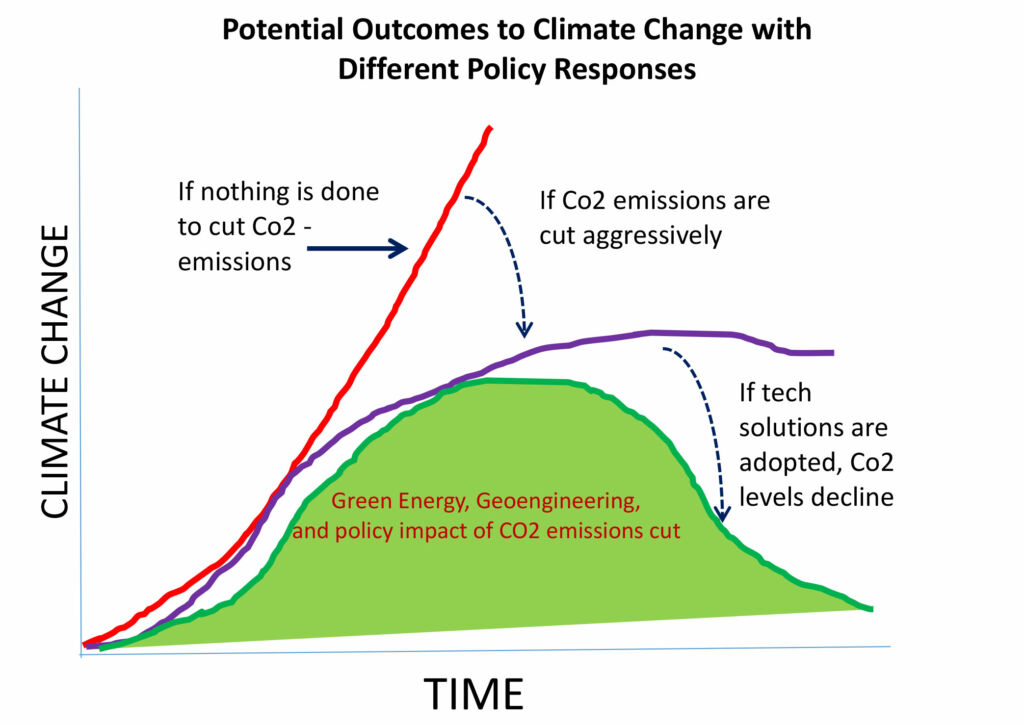 Chart Modified and Adopted from the Union of Concerned Scientists: https://www.ucsusa.org/resources/what-solar-geoengineering
Chart Modified and Adopted from the Union of Concerned Scientists: https://www.ucsusa.org/resources/what-solar-geoengineering
“Everything Everywhere All at Once” is the name of a sci-fi movie released in 2022 in which the protagonist is a time-traveling laundromat owner with tax issues. A.O. Scott, “‘Everything Everywhere All at Once’ Review: It’s Messy, and Glorious,” March 24, 2022, New York Times, https://www.nytimes.com/2022/03/24/movies/everything-everywhere-all-at-once-review.html
The views expressed in this article are those of the author and do not reflect the official policy or position of DKI APCSS, the Department of Defense, or the U.S. Government. The appearance of external hyperlinks does not constitute endorsement by the United States Department of Defense (DoD) of the linked websites, or the information, products, or services contained therein. DoD does not exercise any editorial, security, or other control over the information you may find at these sites.
November 2023
Published: November 9, 2023
Category: Perspectives
Volume: 24 - 2023

